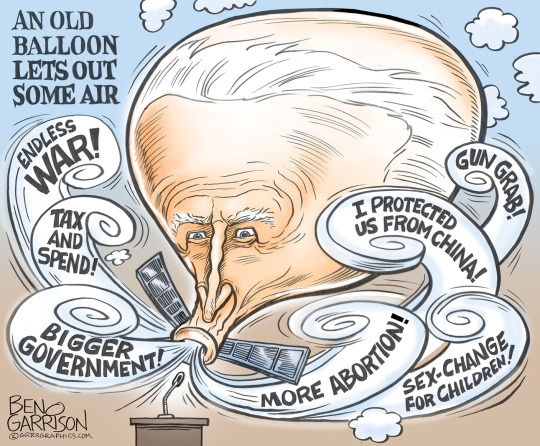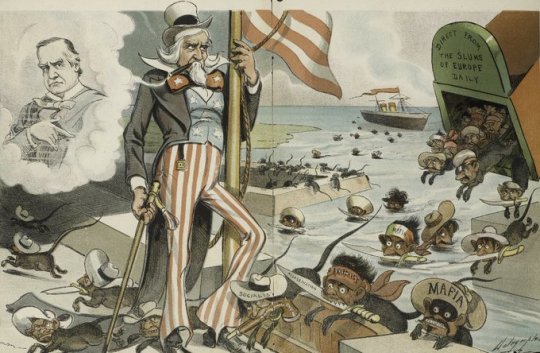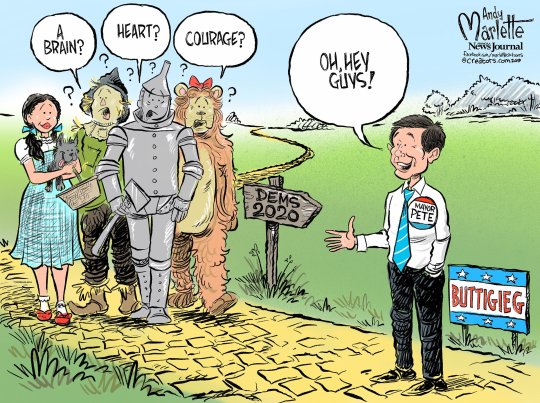#cartoon pete buttigieg
Text
canon moment
0 notes
Text
Branco and Ben Garrison Cartoons: Hot Air Balloons and Pete Buttigieg's Toxic Environment
Branco and Ben Garrison Cartoons:
Hot Air Balloons and Pete Buttigieg’s Toxic Environment
NEW #BenGarrison Cartoon #BidenSOTU
Just A Bunch Of Hot Air!
Biden will accept no blame for any of the problems he created & he’ll likely create more as his stolen presidency continues.A lot of people refused to watch Joe’s speech, but I am forced to watch such things because it’s part of my duty as an…

View On WordPress
0 notes
Text

This political cartoon by Louis Dalrymple appeared in Judge magazine in 1903. It depicts European immigrants as rats. Nativism and anti-immigration have a long and sordid history in the United States.
* * * *
LETTERS FROM AN AMERICAN
March 28, 2024
HEATHER COX RICHARDSON
MAR 29, 2024
Yesterday the National Economic Council called a meeting of the Supply Chain Disruptions Task Force, which the Biden-Harris administration launched in 2021, to discuss the impact of the collapse of the Francis Scott Key Bridge and the partial closure of the Port of Baltimore on regional and national supply chains. The task force draws members from the White House and the departments of Transportation, Commerce, Agriculture, Defense, Labor, Health and Human Services, Energy, and Homeland Security. It is focused on coordinating efforts to divert ships to other ports and to minimize impacts to employers and workers, making sure, for example, that dock workers stay on payrolls.
Today, Transportation Secretary Pete Buttigieg convened a meeting of port, labor, and industry partners—ocean carriers, truckers, local business owners, unions, railroads, and so on—to mitigate disruption from the bridge collapse. Representatives came from 40 organizations including American Roll-on Roll-off Carrier; the Georgia Ports Authority; the International Longshoremen’s Association, the International Organization of Masters, Mates and Pilots; John Deere; Maersk; Mercedes-Benz North America Operations; Seabulk Tankers; Under Armour; and the World Shipping Council.
Today the U.S. Department of Transportation’s Federal Highway Administration announced it would make $60 million available immediately to be used as a down payment toward initial costs. Already, though, some Republicans are balking at the idea of using new federal money to rebuild the bridge, saying that lawmakers should simply take the money that has been appropriated for things like electric vehicles, or wait until insurance money comes in from the shipping companies.
In 2007, when a bridge across the Mississippi River in Minneapolis suddenly collapsed, Congress passed funding to rebuild it in days and then-president George W. Bush signed the measure into law within a week of the accident.
In the past days, we have learned that the six maintenance workers killed when the bridge collapsed were all immigrants, natives of Mexico, Honduras, Guatemala, and El Salvador. Around 39% of the workforce in the construction industry around Baltimore and Washington, D.C., about 130,000 people, are immigrants, Scott Dance and María Luisa Paúl reported in the Washington Post yesterday.
Some of the men were undocumented, and all of them were family men who sent money back to their home countries, as well. From Honduras, the nephew of one of the men killed told the Associated Press, “The kind of work he did is what people born in the U.S. won’t do. People like him travel there with a dream. They don’t want to break anything or take anything.”
In the Philadelphia Inquirer today, journalist Will Bunch castigated the right-wing lawmakers and pundits who have whipped up native-born Americans over immigration, calling immigrants sex traffickers and fentanyl dealers, and even “animals.” Bunch illustrated that the reality of what was happening on the Francis Scott Key Bridge when it collapsed creates an opportunity to reframe the immigration debate in the United States.
Last month, Catherine Rampell of the Washington Post noted that immigration is a key reason that the United States experienced greater economic growth than any other nation in the wake of the coronavirus pandemic. The surge of immigration that began in 2022 brought to the U.S. working-age people who, Director Phill Swagel of the nonpartisan Congressional Budget Office wrote, are expected to make the U.S. gross domestic product about $7 trillion larger over the ten years from 2023 to 2034 than it would have been otherwise. Those workers will account for about $1 trillion dollars in revenues.
Curiously, while Republican leaders today are working to outdo each other in their harsh opposition to immigration, it was actually the leaders of the original Republican Party who recognized the power of immigrants to build the country and articulated an economic justification for increased immigration during the nation’s first major anti-immigrant period.
The United States had always been a nation of immigrants, but in the 1840s the failure of the potato crop in Ireland sent at least half a million Irish immigrants to the United States. As they moved into urban ports on the East Coast, especially in Massachusetts and New York, native-born Americans turned against them as competitors for jobs.
The 1850s saw a similar anti-immigrant fury in the new state of California. After the discovery of gold there in 1848, native-born Americans—the so-called Forty Niners—moved to the West Coast. They had no intention of sharing the riches they expected to find. The Indigenous people who lived there had no right to the land under which gold lay, native-born men thought; nor did the Mexicans whose government had sold the land to the U.S. in 1848; nor did the Chileans, who came with mining skills that made them powerful competitors. Above all, native-born Americans resented the Chinese miners who came to work in order to send money home to a land devastated by the first Opium War.
Democrats and the new anti-immigrant American Party (more popularly known as the “Know Nothings” because members claimed to know nothing about the party) turned against the new immigrants, seeing them as competition that would drive down wages. In the 1850s, Know Nothing officials in Massachusetts persecuted Catholics and deported Irish immigrants they believed were paupers. In California the state legislature placed a monthly tax on Mexican and Chinese miners, made unemployment a crime, took from Chinese men the right to testify in court, and finally tried to stop Chinese immigration altogether by taxing shipmasters $50 for each Chinese immigrant they brought.
When the Republicans organized in the 1850s, they saw society differently than the Democrats and the Know Nothings. They argued that society was not made up of a struggle over a limited economic pie, but rather that hardworking individuals would create more than they could consume, thus producing capital that would make the economy grow. The more people a nation had, the stronger it would be.
In 1860 the new party took a stand against the new laws that discriminated against immigrants. Immigrants’ rights should not be “abridged or impaired,” the delegates to its convention declared, adding that they were “in favor of giving a full and efficient protection to the rights of all classes of citizens, whether native or naturalized, both at home and abroad.”
Republicans’ support for immigration only increased during the Civil War. In contrast to the southern enslavers, they wanted to fill the land with people who supported freedom. As one poorly educated man wrote to his senator, “Protect Emegration and that will protect the Territories to Freedom.”
Republicans also wanted to bring as many workers to the country as possible to increase economic development. The war created a huge demand for agricultural products to feed the troops. At the same time, a terrible drought in Europe meant there was money to be made exporting grain. But the war was draining men to the battlefields of Stones River and Gettysburg and to the growing U.S. Navy, leaving farmers with fewer and fewer hands to work the land.
By 1864, Republicans were so strongly in favor of immigration that Congress passed “an Act to Encourage Immigration.” The law permitted immigrants to borrow against future homesteads to fund their voyage to the U.S., appropriated money to provide for impoverished immigrants upon their arrival, and, to undercut Democrats’ accusations that they were simply trying to find men to throw into the grinding war, guaranteed that no immigrant could be drafted until he announced his intention of becoming a citizen.
Support for immigration has waxed and waned repeatedly since then, but as recently as 1989, Republican president Ronald Reagan said: “We lead the world because, unique among nations, we draw our people—our strength—from every country and every corner of the world. And by doing so we continuously renew and enrich our nation…. Thanks to each wave of new arrivals to this land of opportunity, we're a nation forever young, forever bursting with energy and new ideas, and always on the cutting edge, always leading the world to the next frontier. This quality is vital to our future as a nation. If we ever closed the door to new Americans, our leadership in the world would soon be lost.”
The workers who died in the bridge collapse on Tuesday “were not ‘poisoning the blood of our country,’” Will Bunch wrote, quoting Trump; “they were replenishing it…. They may have been born all over the continent, but when these men plunged into our waters on Tuesday, they died as Americans.”
LETTERS FROM AN AMERICAN
HEATHER COX RICHARDSON
#immigration#history#Letters From An American#Heather Cox Richardson#Know Nothings#supply chains#economic growth
3 notes
·
View notes
Photo

that’s it. that’s the chart.
#nah i'm kidding#our cartoon president#ocp#showtime#alignment chart#meme#cartoon pete buttigieg#pete buttigieg
12 notes
·
View notes
Text

Credit: Trump Villain Cards (@MAGAsMostWanted)
#politics#us politics#political cartoon#sebastian gorka#farhana khera#white supremacists#islamophobia#anti semitism#homophobia#pete buttigieg#muslim advocates#nbc news#media matters#the atlantic#buzzfeed#mia bloom#georgia state university#the daily beast#katie gorka#vitezi rend#@magasmostwanted#trump villain cards#neo nazis#nazi
4 notes
·
View notes
Photo

#editorial cartoons#Phil Hands#Democratic debate#Mike Bloomberg#moderates#money#Joe Biden#Amy Klobuchar#Pete Buttigieg#Mayor Pete#political cartoon
24 notes
·
View notes
Photo

Cartoon of the Day: 12-20-19: 354/365. Meanwhile, in the wine cave...
#cartoon#cartoon of the day#daily cartoon#political cartoon#editorial cartoon#democratic debate#pete buttigieg#mayor pete#wine cave#election 2020
19 notes
·
View notes
Text

YES YES YES!
28 notes
·
View notes
Photo

Behbeh
#pete#pete buttigieg#buttigieg#boot edge edge#mayor pete#iowa caucus#politics#American politics#cartoon#teddy bear#democrat#gay#gayor#donkey#illustration#dailybehbeh#behbeh#cute#stuffed animal#trending#humor#hilarious#adorable#polar bear#bear#art#funny#daily#daily news#daily bear
7 notes
·
View notes
Photo

My latest cartoon in today’s Boston Globe:
#cory booker#kamala harris#julian castro#amy klobuchar#elizabeth warren#kirsten gillibrand#pete buttigieg#bernie sanders#beto o'rourke#joe biden#john hickenlooper#jay inslee#andrew yang#donald trump#boston globe#editorial cartoons#ward sutton#sutton impact
86 notes
·
View notes
Photo

White Guy Welcome to the race, Beto O'Rourke!
#american history#bernie sanders#beto orourke#cartoon#comic#delaney#dnc#hickenlooper#inslee#Joe Biden#mayor pete#pete buttigieg#political cartoon#presidents#trump#two party opera
2 notes
·
View notes
Photo

Lament for a Son In order to understand the title of this cartoon you need to read the commentary that undergirds it. You can do that at DoodleJesus.com Happy Friday...
1 note
·
View note
Text

In case you missed it: The Mileage Tax is just Buttigieg’s First Act http://dlvr.it/RxQ3wW
0 notes
Photo


why are you smiling boy
#he's the only one smiling at this#our cartoon president#ocp#showtime#cartoon joe biden#joe biden#cartoon elizabeth warren#elizabeth warren#cartoon pete buttigieg#pete buttigieg#cartoon bernie sanders#bernie sanders#cartoon amy klobuchar#amy klobuchar#Election Security#season 3
15 notes
·
View notes
Text
[Q:] You took a significant share of criticism on Twitter during the primary, particularly from members of your own Millennial generation, who saw you as a political opportunist, a corporate shill, and not being gay enough. Some even suggested you were affiliated with the CIA. What did you make of that?
[A:] You learn very early on in politics not to take criticism personally. I would much rather have somebody go online or write an article and say, “Your higher ed policy sucks and here’s why…” and critique it point-by-point. Then we could have a debate. But when it gets so over the top, the idea that I’m a CIA agent cleverly disguised as an intelligence officer in the military, or that I took down Blue Cross Blue Shield Michigan, or that I was somehow responsible for the Great Canadian Bread Pricing Scandal of 2002. Or perhaps the most bizarre one of all: That I had something to do with the app crashing in Iowa when no individual suffered more or was impacted more, I think, in terms of political trajectory as a consequence of that then than me and my campaign.
That’s where you learn that, okay, yes it is personal, but it’s still not about you. It’s about a cartoon character version of you that people are building up and then tearing back down as a way of expressing their frustration with things that are bigger than you or that you may remind them of. But it’s actually not about you, because the caricature they’re talking about doesn’t even resemble you.
Loved Pete Buttigieg’s response to this question from the Indianapolis Monthly about how the dirtbag left has attacked him. One of my first impressions of Pete, I thought “this guy has very healthy boundaries and seems to have either done the therapy circuit or is very well-adjusted.” Though It’s clear that so much of the maliciousness of the primary has had a personal effect, I’m glad to see this.
Pete remembers this and so do we, and they wonder how we all ended up forgoing their candidate.
Just as with many other candidates, unfortunately.
108 notes
·
View notes
Link
Bernie Sanders’ supporters are often accused of being conspiratorial when they say there is a bias against him in the press—Bernie himself has been called “Trumpian” for criticizing the media. But if you watched last night’s PBS NewsHour, you got a real taste of what Bernie is talking about. Remember that Sanders has been No. 1 in two out of three recent New Hampshire polls, and is currently second in Iowa, ahead of “frontrunner” Joe Biden. Now watch NewsHour correspondent Yamiche Alcindor’s update from the campaign trail:
youtube
Let us look closely at what happens here. Alcindor begins over a shot of Joe Biden in front of his new “No Malarkey” bus, saying that we have a “Democratic field” in flux, which is true. She mentions “candidates on the rise” “shoring up weaknesses” over a shot of Pete Buttigieg, “candidates whose campaigns are lagging” over a shot of Kamala Harris asking a woman “What are the challenges for you as a small business owner?” and candidates dropping out. Here Alcindor dwells on the candidacy of Steve Bullock, who left the race Monday morning (“and nobody cared,” reported CNN) She quotes Bullock’s statement, then mentions Joe Sestak, another forgettable dropout, over some pictures of him.
We are then back to Buttigieg, who “hoped to build on his strong standing in Iowa” at a visit to a black church. We are told that Buttigieg has a new campaign ad out. We see some of the campaign ad, Buttigieg saying something about “the hope of the American experience” and talking about how “unifying” the country doesn’t mean “pretending we’re all the same.” We then see more pictures of Joe Biden in Iowa, “where his support has been losing steam.” We are told about the “No Malarkey bus tour” and given a snippet from one of Biden’s speeches. Then it’s back to Kamala Harris (“During the holiday shopping period, she spoke with small business owners…”) and the bad publicity of a recent New York Times report on the poor performance of her campaign. Then we get a look at what’s happening with Amy Klobuchar. She has, we are told, a new campaign ad. We get to see a piece of the ad. Then, Alcindor covers Cory Booker, for whom “Iowa was a focus, too.” Booker brags that he is No. 3 in net favorability in Iowa but admits it’s “not translating to people choosing me in the polls.” Then, we check in on Elizabeth Warren: We hear a clip of her telling an attendee at a town hall a moving story about the end of her first marriage. Warren then gives the questioner a hug. “A quiet, deeply personal moment, even in the rush to the first in the nation caucuses, just two months away,” Alcindor concludes.
Thus ends the Democratic primary update! Did you notice something missing? Alcindor found time to talk about Joe Sestak and Steve Bullock, plus plenty of candidates struggling to get out of single-digit poll numbers. And yet: not even a photo of Bernie Sanders. Incredible. He’s just… erased. He’s gone. Bernie who? I’m constantly reminded of Jason Adam Katzenstein‘s wonderful Current Affairs cartoon:

(Continue Reading)
159 notes
·
View notes